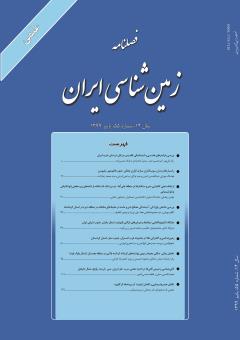بررسی شاخص یخزدگی– آبشدگی مصالح شن و ماسه در محیطهای مختلف در منطقه دیره در استان کرمانشاه
محورهای موضوعی :کاظم بهرامي 1 , سید محمود فاطمی عقدا 2 , علی نورزاد 3 , مهدی تلخابلو 4
1 - گروه زمين شناسي مهندسي، دانشگاه تربيت مدرس
2 - دانشگاه خوارزمی
3 - دانشگاه شهید بهشتی
4 - دانشگاه خوارزمی
کلید واژه: مخروطافکنه, محیطهای زمین¬شناسی, سنگدانه, یخزدگی- آبشدگی,
چکیده مقاله :
با توجه به تأثیری که محیط های زمین شناسی تجمع سنگدانههای طبیعی می تواند در میزان افت وزنی ناشی از یخ زدگی- آب شدگی سنگدانهها داشته باشد، در این پژوهش، ارتباط محیط های زمین شناسی و میزان افت وزنی سنگدانهها مورد بررسی قرار گرفته است. محل های نمونه برداری شامل دو واریزه، 12 مخروط افکنه و سه بستر رودخانه ای بوده و از هر محل دو نمونه برداشته شده است. لیتولوژی حوضه بالادست برای همه نمونه ها یکسان و شامل آهک آسماری است. نمونههای برداشت شده به آزمایشگاه منتقل و میزان افت وزنی ناشی از یخ زدگی- آب شدگی مطابق با استانداردTEX-432-A به دست آمد همچنین درصد سنگدانههای دارای درزه از طریق بررسی های چشمی اندازه گیری شد. نتایج به دست آمده از این تحقیق نشان می دهد که محیط های واریزه ای بیشترین میزان افت وزنی (14 درصد برای اندازه mm19-16) و محیط های رودخانه ای کمترین میزان افت وزنی (کمتر از یک درصد برای اندازه mm75/4-36/2) را دارند. مخروط افکنه ها نیز حالتی حد واسط این دو را دارند. با افزایش مساحت حوضه بالادست از 25 تا 309 هکتار و افزایش طول آبراهه اصلی از یک تا بیش از سه کیلومتر میزان افت وزنی کاهش می یابد. مهمترین علت این اختلاف میزان افت وزنی شدت درزه داری سنگدانهها و تخلخل ناشی از هوازدگی بیشتر در محیط های واریزه ای است که به ترتیب در محیط های مخروط افکنه ای و رودخانه ای کمتر می شود. اندازه سنگدانهها نیز بر روی میزان افت وزنی تأثیر گذار است بهطوریکه با افزایش اندازه، میزان افت وزنی افزایش می یابد. ارتباط اندازه ذرات با میزان افت وزنی متأثر از محیط های زمین شناسی است. در محیط های واریزه ای و مخروط افکنه های با حوضه بالادست کوچک اختلاف افت وزنی سنگدانههای درشت و ریز بیشتر است و در بسترهای رودخانه ای و مخروط افکنه های با حوضه بالادست بزرگ اختلاف افت وزنی سنگدانههای درشت و ریز کمتر است. در واقع در بسترهای رودخانهای و مخروطافکنههای دارای حوضه بالادستی بزرگ اثر اندازه ذرات در میزان افت وزنی کاهش یا از بین می رود.
Considering the effects of geological environments of natural aggregates accumulation on the weight loss rate of aggregates resulted from freezing-thawing, the relationship between geological environments and the weight loss rate of aggregates has been investigated in this study. The lithology of upstream catchment was the same (thick Asmari limestone) for all aggregates samples. Samples were gathered from 2 taluses, 12 fans and 3 river beds. Samples were transferred to laboratory and then the weight loss rate (in accordance with tex-432- A standard) and the jointing intensity were measured. Based on the results, colluvial environments (taluses) have the highest weight loss rate (14% for size of 16-19 mm) and river environments have the lowest weight loss rate (less than 1% for size of 2.36-4.75 mm). The aggregates of alluvial fans have the intermediate amount compared to two previous environments. In alluvial fan aggregates, the weight loss rate decreases when the area and length of main stream of catchments increases. Also, aggregates size affects the weight loss rate so that increase in the size of aggregate causes the rise in weight loss. Relationship between aggregate size and weight loss rate is affected by geological environments. The difference of weight loss between fine and coarse aggregates is high in talus environments as well as alluvial fans with small catchments, while it is less in river beds and fans with large catchments. In fact, the size effect of aggregate on weight loss decreases or eliminated in river beds and fans.


